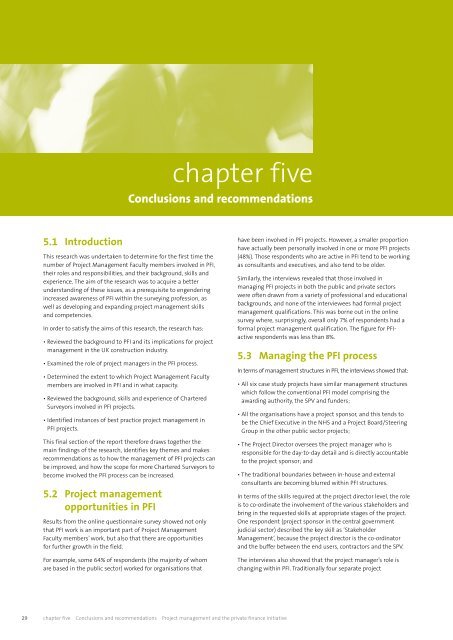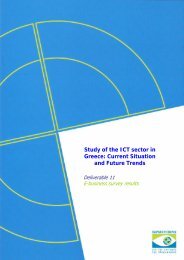Project management and the private finance initiative
Project management and the private finance initiative
Project management and the private finance initiative
Create successful ePaper yourself
Turn your PDF publications into a flip-book with our unique Google optimized e-Paper software.
5.1 Introduction<br />
chapter five<br />
Conclusions <strong>and</strong> recommendations<br />
This research was undertaken to determine for <strong>the</strong> first time <strong>the</strong><br />
number of <strong>Project</strong> Management Faculty members involved in PFI,<br />
<strong>the</strong>ir roles <strong>and</strong> responsibilities, <strong>and</strong> <strong>the</strong>ir background, skills <strong>and</strong><br />
experience. The aim of <strong>the</strong> research was to acquire a better<br />
underst<strong>and</strong>ing of <strong>the</strong>se issues, as a prerequisite to engendering<br />
increased awareness of PFI within <strong>the</strong> surveying profession, as<br />
well as developing <strong>and</strong> exp<strong>and</strong>ing project <strong>management</strong> skills<br />
<strong>and</strong> competencies.<br />
In order to satisfy <strong>the</strong> aims of this research, <strong>the</strong> research has:<br />
• Reviewed <strong>the</strong> background to PFI <strong>and</strong> its implications for project<br />
<strong>management</strong> in <strong>the</strong> UK construction industry.<br />
• Examined <strong>the</strong> role of project managers in <strong>the</strong> PFI process.<br />
• Determined <strong>the</strong> extent to which <strong>Project</strong> Management Faculty<br />
members are involved in PFI <strong>and</strong> in what capacity.<br />
• Reviewed <strong>the</strong> background, skills <strong>and</strong> experience of Chartered<br />
Surveyors involved in PFI projects.<br />
• Identified instances of best practice project <strong>management</strong> in<br />
PFI projects.<br />
This final section of <strong>the</strong> report <strong>the</strong>refore draws toge<strong>the</strong>r <strong>the</strong><br />
main findings of <strong>the</strong> research, identifies key <strong>the</strong>mes <strong>and</strong> makes<br />
recommendations as to how <strong>the</strong> <strong>management</strong> of PFI projects can<br />
be improved, <strong>and</strong> how <strong>the</strong> scope for more Chartered Surveyors to<br />
become involved <strong>the</strong> PFI process can be increased.<br />
5.2 <strong>Project</strong> <strong>management</strong><br />
opportunities in PFI<br />
Results from <strong>the</strong> online questionnaire survey showed not only<br />
that PFI work is an important part of <strong>Project</strong> Management<br />
Faculty members’ work, but also that <strong>the</strong>re are opportunities<br />
for fur<strong>the</strong>r growth in <strong>the</strong> field.<br />
For example, some 64% of respondents (<strong>the</strong> majority of whom<br />
are based in <strong>the</strong> public sector) worked for organisations that<br />
29 chapter five Conclusions <strong>and</strong> recommendations <strong>Project</strong> <strong>management</strong> <strong>and</strong> <strong>the</strong> <strong>private</strong> <strong>finance</strong> <strong>initiative</strong><br />
have been involved in PFI projects. However, a smaller proportion<br />
have actually been personally involved in one or more PFI projects<br />
(48%). Those respondents who are active in PFI tend to be working<br />
as consultants <strong>and</strong> executives, <strong>and</strong> also tend to be older.<br />
Similarly, <strong>the</strong> interviews revealed that those involved in<br />
managing PFI projects in both <strong>the</strong> public <strong>and</strong> <strong>private</strong> sectors<br />
were often drawn from a variety of professional <strong>and</strong> educational<br />
backgrounds, <strong>and</strong> none of <strong>the</strong> interviewees had formal project<br />
<strong>management</strong> qualifications. This was borne out in <strong>the</strong> online<br />
survey where, surprisingly, overall only 7% of respondents had a<br />
formal project <strong>management</strong> qualification. The figure for PFIactive<br />
respondents was less than 8%.<br />
5.3 Managing <strong>the</strong> PFI process<br />
In terms of <strong>management</strong> structures in PFI, <strong>the</strong> interviews showed that:<br />
• All six case study projects have similar <strong>management</strong> structures<br />
which follow <strong>the</strong> conventional PFI model comprising <strong>the</strong><br />
awarding authority, <strong>the</strong> SPV <strong>and</strong> funders;<br />
• All <strong>the</strong> organisations have a project sponsor, <strong>and</strong> this tends to<br />
be <strong>the</strong> Chief Executive in <strong>the</strong> NHS <strong>and</strong> a <strong>Project</strong> Board/Steering<br />
Group in <strong>the</strong> o<strong>the</strong>r public sector projects;<br />
• The <strong>Project</strong> Director oversees <strong>the</strong> project manager who is<br />
responsible for <strong>the</strong> day-to-day detail <strong>and</strong> is directly accountable<br />
to <strong>the</strong> project sponsor; <strong>and</strong><br />
• The traditional boundaries between in-house <strong>and</strong> external<br />
consultants are becoming blurred within PFI structures.<br />
In terms of <strong>the</strong> skills required at <strong>the</strong> project director level, <strong>the</strong> role<br />
is to co-ordinate <strong>the</strong> involvement of <strong>the</strong> various stakeholders <strong>and</strong><br />
bring in <strong>the</strong> requested skills at appropriate stages of <strong>the</strong> project.<br />
One respondent (project sponsor in <strong>the</strong> central government<br />
judicial sector) described <strong>the</strong> key skill as ‘Stakeholder<br />
Management’, because <strong>the</strong> project director is <strong>the</strong> co-ordinator<br />
<strong>and</strong> <strong>the</strong> buffer between <strong>the</strong> end users, contractors <strong>and</strong> <strong>the</strong> SPV.<br />
The interviews also showed that <strong>the</strong> project manager’s role is<br />
changing within PFI. Traditionally four separate project

















